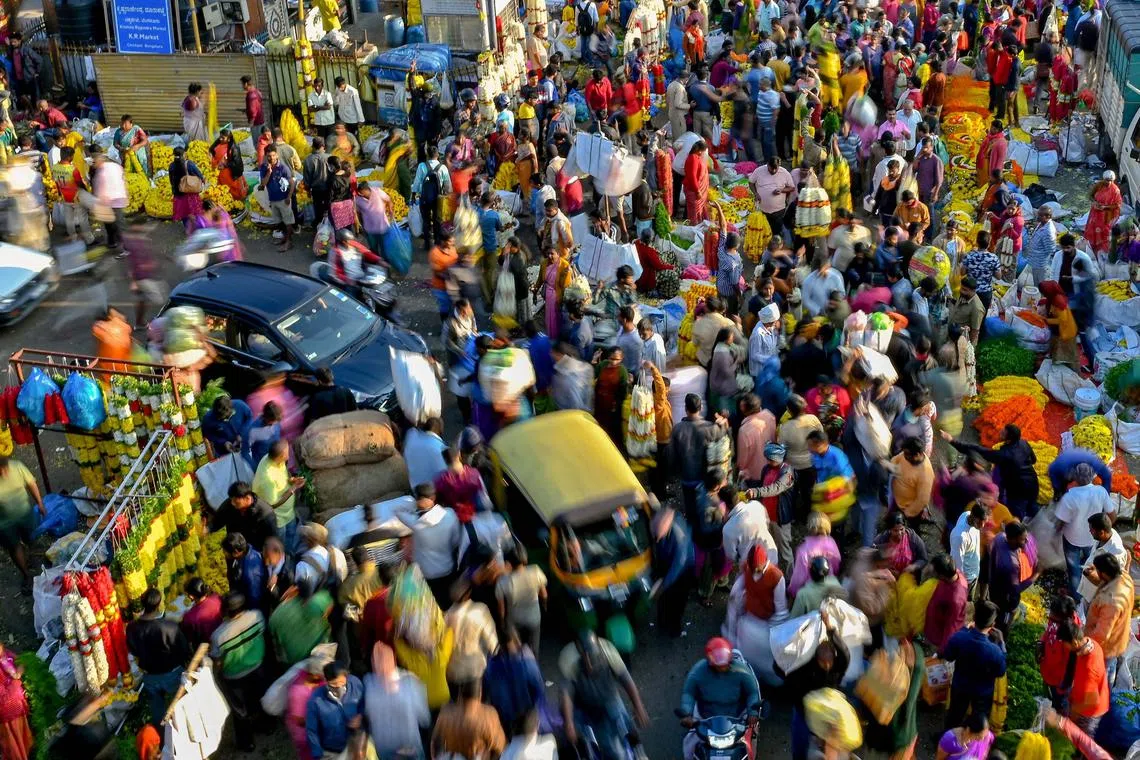India pushes for trade in rupees to boost exports amid global trade slowdown
Sign up now: Get ST's newsletters delivered to your inbox

India said it will allow countries to use the rupee in Indian accounts to pay for projects and invest in government securities.
PHOTO: AFP
Follow topic:
NEW DELHI – India and Bangladesh have agreed in principle to use local currency for trade in a boost for New Delhi’s efforts to internationalise the rupee, reduce dollar demand and cushion Indian exports amid global headwinds.
India, among the world’s fastest-growing economies, has made using the rupee in international transactions a key part of its 2023 policy on foreign trade which was unveiled on March 31.
Officials said India is ready to trade in its currency with countries that are facing a shortage of US dollars amid a slowdown in global trade.
Global trade was worth a record US$32 trillion (S$43 trillion) in 2022, but growth is set to stagnate in the first half of 2023 on the back of geopolitical tensions and concerns about inflation and high commodity prices – especially for energy, food and metals, according to the Global Trade Update, published by the United Nations Conference on Trade and Development in March.
Mr Mezbaul Haque, executive director and spokesman for Bangladesh Bank, the country’s central bank, told The Straits Times from Dhaka that the move will benefit traders of both countries.
“We have agreed in principle (for rupee transactions) and now we are working on the procedures,” he said.
“It will take a couple of months (to operationalise) because permission is required from the central bank to open an account for traders. Definitely, this will reduce the transaction cost for business, so that will encourage traders to do more business.”
India-Bangladesh trade in 2021-2022 was US$18.2 billion.
Bangladeshi banks will set up a rupee account, known as a vostro account, with Indian banks, while Indian banks will do the same with Bangladeshi banks. This will enable Indian traders to receive and give rupee payments through these accounts. Similarly, Bangladeshi traders can also use its currency, taka, for trade.
The Bangladesh-India rupee trade agreement comes close on the heels of Malaysia agreeing to conduct trade with India using the rupee.
The Union Bank of India has opened a special rupee vostro account with the India International Bank Malaysia (IIBM), and said in a statement that this will “help achieve better pricing for goods and services traded” and save on currency conversion.
Similarly, IIBM has opened a special rupee vostro account with the Union Bank of India, the Indian High Commission in Kuala Lumpur said in a press release.
Bilateral trade with Malaysia, the third-largest trading partner of India in Asean, was US$19.4 billion during 2021 to 2022.
In 2022, the Reserve Bank of India (RBI) decided to allow the settlement of international trade in rupees to help push trade and make the currency international, in line with India’s growing aspirations as a global leader.
India said it will also allow countries to use the rupee in Indian accounts to pay for projects and invest in government securities.
RBI, according to Indian media reports, has approved 60 requests to open special rupee vostro accounts from 18 countries, including Britain and Germany. Indian media reports said discussions are on with a host of other countries like Cuba and Tajikistan.
“We will soon start seeing operationalisation of rupee trading in international trade with several countries,” Commerce Minister Piyush Goyal told reporters last Saturday.
Still, trade experts expect challenges.
“With many of these countries, India is actually running a trade deficit. With Malaysia, we are running a huge trade deficit. Same is the case with Russia. So what happens is that a partner country could get saddled with a whole lot of rupees which they may not want,” said foreign trade expert Biswajit Dhar.
India’s trade deficit with Malaysia was US$5 billion in 2021-2022. With Russia, it was around US$38 billion between April 2022 and February 2023.
The rupee depreciated the most among Asian emerging economies in 2022.
RBI, in a 2022 report, highlighted potential risks, including limiting the central bank’s ability to control domestic money supply due to cross-border trade in rupees.
“Observers expect this mechanism to initially gain traction with neighbouring countries, or those with which India runs a trade surplus, besides other partners which are looking to broaden their pool of trade settlement currencies and/or those which are temporarily outside the international (mainly dollar) trading system,” said Ms Radhika Rao, senior economist and executive director at DBS Bank.
The idea of internationalising the rupee took root after India sought to revive a rupee-rouble arrangement with Russia to bypass Western sanctions over the Ukraine war.
But that arrangement has run into trouble, with Russia saying that Indian banks with exposure to the US were wary of attracting sanctions, while Russia is wary of finding itself with large piles of rupees.
India has an ambitious export target, looking to reach US$2 trillion by 2030, up from US$770 billion in 2022 to 2023.
Said Mr Najib Shah, former chairman of the Central Board of Excise and Customs: “From India’s perspective, there are huge advantages. It will lessen pressure on the rupee and save foreign exchange. More and more countries are coming on board, which means countries are seeing some advantage for them as well.
“We have to wait and see how it will pan out.”


